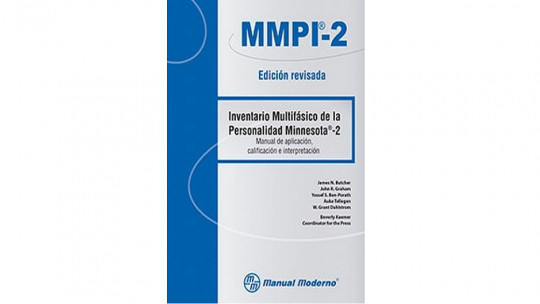Each of us has our own way of being We observe the world in certain ways, we relate to others in certain ways, and in general we express a tendency to do certain things and respond in more or less stable ways.
In other words, and although it may sound redundant, each person has their own personality. This concept, which defines who and how we are, has been a classic object of study in psychology, with numerous measuring instruments having been created to evaluate it known as personality tests.
Among all of them, the Factorial Personality Questionnaire or Test of the 16 Personality Factors also known as 16PF, originally created by psychologist Raymond Cattell.
A brief introduction: what is personality?
As we have mentioned before, Personality is a general pattern of behavior, interaction, coping, and relationships and perception of reality that each individual possesses. This general pattern is a stable and consistent element that is generated throughout the life of each person, being forged especially from childhood to the beginning of adulthood through a combination of biopsychosocial elements (genetics, environment and personal experiences). from each person).
Personality can vary in some aspect in response to specific life situations and developments, but it is generally maintained throughout the life cycle, remaining constant in most areas and through the different situations we experience. This does not mean that specific aspects are unchangeable, but it requires a high level of effort and work, generally maintaining the set of characteristics that make up the personality.
The study of personality
The main objectives of the study of personality have been to find and explain the main individual differences between subjects regarding their behavior, based on the measurement of different traits. From these measurements, an assessment of the characteristics of the individuals can be made based on the comparison with the population average. contributing to making predictions about one’s own and others’ behavior and assessing their suitability to the environment
But it must be taken into account that personality is not an easily identifiable objective element, but rather an abstract construct that is difficult to quantify. To develop instruments that measure personality, different types of criteria have had to be used, such as empirical or rational ones.
One of the methods of constructing personality measurement instruments is based on factorial criteria, in which the relationship between different characteristics is sought in order to establish groups of traits, which are known as personality factors. Taking these types of criteria into account, In 1957, Raymond Cattell constructed one of the most famous personality tests, the 16 PF
Getting into the subject: 16 PF
The Factorial Personality Questionnaire or 16 PF is one of the most well-known and used personality measurement instruments throughout the young history of Psychology. Created as already mentioned by Raymond Cattell based on factorial criteria, this evaluation instrument’s main function is to study and assess personality traits based on various factors (sixteen main and five secondary or global factors in the latest version).
These factors are bipolar, that is, they go on a continuum that goes from one end of the trait to the other, with the score of the person evaluated being located at some point on said continuum.
To make it easier to understand: If one of the factors is dominance, one of the poles reflects an authoritarian, competitive and independent person while the other would indicate a person who is submissive, conformist and dependent on others, with the majority of the population being in an intermediate situation.
Internal organization of the personality test
This personality test is organized from a total of 185 closed questions with three answer options, one of the options indicating that one does not know what to answer, with the exception of some questions posed as problem solving to evaluate intelligence. . As it is based on questions and does not require very advanced technologies to provide a result, It has been widely used in companies and all types of organizations when selecting personnel who can become part of the team or receive a promotion.
The score obtained from the 16 PF is calculated from templates, in which the value of each of the items is taken into account in predicting the factor that corresponds to them, there being around ten to fourteen per factor, and passing said direct scoring to scaled decatypes.
The 16 PF consists of different types of scales In its fifth version there are three scales used in order to detect response styles, being able to assess the sincerity and verifiability of the data obtained, four global or secondary scales and finally sixteen personality factors that are assessed in this personality test. .
Population in which to apply it
The type of population for which the 16 PF is designed is those subjects from sixteen years of age, requiring a level of understanding similar to that of a second-year ESO student to be able to perform it correctly. This is necessary, among other things, to ensure that everyone has sufficient skills to understand the basic operation of the test and how to apply it
Despite this, there are different variants of this personality test, with some versions being more aimed at people with reading difficulties or sociocultural problems.
Objectives and application
The 16PF is designed for do an analysis of traits and response styles of the person to be evaluated, and with its interpretation a basic profile of the subject’s personality can be obtained.
This personality test is very useful, being frequently applied in areas such as research, organizational psychology and human resources, and clinical psychology. However, the idea of this questionnaire is to evaluate typical personality, not being focused on the analysis of psychopathology (although through its observation traits that tend towards some anomaly could be appreciated, this is not its objective and it is not prepared for the diagnosis of disorders).
Interpret 16 FP
When analyzing the results, the general steps are to first observe the response styles to see if the test results are reliable, and then assess global dimensions and extreme decatypes which serve as a general idea of the patient’s situation and profile when extracted from the scores of the rest of the scales and finally analyze and interpret the score of each of the 16 primary scales, with the help of the test itself and external guides.
The 16 PF scales and factors
These are the different scales that make up the 16 PF:
1. Response style scales
The main function of the response style scales is to ensure the validity and reliability of the data collected about the patient, observing whether the patient answers correctly and sincerely or whether trends appear that distort the data and therefore the personality analysis.
2. Image manipulation
This scale is responsible for assessing whether the answers given to the questions are sincere or motivated by social desirability, whether to give a good image or to appear to be worse than one is, with secondary objectives.
3. Acquiescence
This scale assesses the tendency to always answer positively to questions, which could indicate a lack of sincerity that makes it difficult to correctly analyze the situation.
4. Infrequency rate
It is used to detect unusual responses. It may be because the person being tested answers at random, although each answer and its correspondence with the entire personality test would have to be analyzed.
Top 16 factors
The main or first-order factors reflect in a broad and specific way the different personality traits. They are the following.
A: Affectiveness: Schizothymia (low affectivity) vs Cyclothymia (high affectivity)
This factor assesses emotional expressiveness Scoring high on this scale implies being affectionate and expressing one’s own emotions, being pleasant to bond with others and having a certain ease in doing so. On the other hand, scoring low would bring the personality closer to the schizothymic pole, being little affective, with poor expressiveness and a high level of rigidity and tendency to isolation.
B: Reasoning: High Intelligence vs Low Intelligence
Although this factor is more linked to intelligence than to personality, It cannot be ignored that having greater or lesser intellectual capacity affects the way we see the world and act in it
A high score would make one think of someone with ease in learning, comprehending and understanding the abstract and adapting to circumstances. Scoring low implies a lower ability to cope with the environment, having greater rigidity and fewer response options and making it difficult to understand the world.
C: Stability: Ego Strength vs Ego Weakness
This factor mainly refers to the stability of the person It is considered that a person who scores high has a tendency to be able to maintain composure and have stable emotionality. A low score would reflect neuroticism, lability, and poor emotional control.
D: Dominance: Dominance vs Submission
The dominance factor refers to the ability to be independent Scoring high means that the behavior pattern is competitive, independent and even authoritarian, while low scores indicate submission and conformity.
E: Impulsivity: Surgency (impulsivity) vs Desurgency (inhibition)
Indicates the motivational capacity and the desire to do things , as well as the ability to self-control. A person who scores high will be sociable, motivated, impetuous and impulsive, while people with low scores will tend to be worried, cautious and anxious.
F: Group conformity: Strong superego vs weak superego
It refers to the capacity for self-control, decision and assessment of others A person who scores high will be determined, stable, committed and will value others but without being carried away by them. Scoring low may indicate frivolity, negligence and immaturity,
G: Daring: Parmia (daring) vs Trectia (shyness)
It is the ability to transform thoughts and wills into actions Scoring high implies daring and spontaneity, while low scores indicate inhibition and shyness that prevents doing things.
H: Sensitivity: Premsia (sensitivity) vs Harria (hardness)
This factor indicates the presence of sensitivity in the person Scoring high makes you think of an emotional, kind and shy, labile person. Low scores indicate emotional toughness, pragmatism and little ability to get excited.
I: Suspicion: Alexia (trust) vs Protension (distrust)
The level of trust or distrust towards others People who score high are distrustful of other people’s intentions, while low scores reflect interest and trust in others, as well as the ability to bond.
J: Imagination: Praxemia (pragmatism) vs Autia (imagination)
The ability to abstract Having a high score refers to the ability to be eccentric and unconventional, imaginative. Scoring low in this aspect reflects a personality focused on reality, with little artistic and conventional interest.
K: Cunning: Subtlety vs. Naivety
Ability to analyze reality exhaustively and observe different options and perspectives People who score high have the ability to detect and analyze both reality and themselves, while those who score low are more naive, gullible and somewhat clumsier in their relationships.
L: Guilt: Conscience vs Imperturbability
It refers to the ability to take responsibility for things High scores indicate apprehension and ease of blaming. Low scores reflect security and serenity.
Q1: Rebellion: Radicalism vs Conservatism
This 16 PF scale indicates the capacity for open-mindedness or respect for traditional ways of doing things Scoring high indicates interest in intellectual things and open-mindedness. Low scores indicate conservatism, traditionality and respect.
Q2: Self-sufficiency: Self-sufficiency vs. Dependency
Reflects the ability to make one’s own decisions these people scoring high on the scale, or the preference for making decisions agreed upon by the group and depending on other people, being in this case the lowest score.
Q3: Self-control: Self-esteem vs. Indifference
It involves measuring emotional and behavioral control A high score suggests the presence of a controlled personality, while a low score reflects carefreeness.
Q4: Tension: Tension vs Tranquility
Refers to the person’s anxiety level Nervous and irritable individuals would score high while calm people would have a lower score.
Second order or global scales
The second-order scales are obtained from the analysis of the sixteen main factors, serving as a general summary of the patient’s situation although providing more general and less precise information than the detailed analysis of each scale.
QS1: Introversion and extraversion
People who are easy to relate to have a high score in this secondary factor, being extraverted. On the other hand, introverts or people who tend to be socially inhibited tend to have a low score.
QS2: Anxiety-Tranquility
Serenity and security are common characteristics in people who score low on this scale. On the other hand, anxious and insecure people tend to have high scores on this scale.
QS3: Susceptibility-Tenacity
People who worry, get frustrated, or get discouraged easily tend to score low, regardless of their level of agreeableness. They are also usually analytical. On the other hand, a high score indicates decision-making capacity and stability, although also a lower level of risk assessment.
QS4: Dependence-Independence
Its high scores reflect independence, assertiveness, disinhibition and radicality, while low scores indicate insecurity, humility, shyness and moralism.









